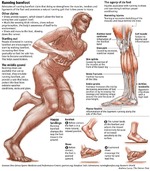Workout: Strength
 Saturday, June 19, 2010 at 0:06 | by
Saturday, June 19, 2010 at 0:06 | by  Darryl Edwards
Darryl Edwards 5 sets of 3 Reps - Deadlifts.
Take a 3-5 minute rest between each set, to ensure full recovery.
 Workouts
Workouts I'm Darryl Edwards (aka The Fitness Explorer), founder of Primal Play, this website is no longer being updated - please check out www.primalplay.com for current details on my work, passion and lifestyle approach.
What is Primal Play?
Eat for Health, Move for Life!
Learn more about We Love Paleo

Find out more and details on how to purchase at www.animalmovesbook.com
"If you are looking for a simple way to better understand Paleo concepts, Darryl's Paleo from A to Z guide is the go-to resource."
-Mark Sisson, best-selling author of The Primal Blueprint and publisher of Mark's Daily Apple
"This book is a useful reference to enable individuals just starting out on the Paleo path as well as those who want to explore more challenging, playful and interesting ways to move."
 Saturday, June 19, 2010 at 0:06 | by
Saturday, June 19, 2010 at 0:06 | by  Darryl Edwards
Darryl Edwards 5 sets of 3 Reps - Deadlifts.
Take a 3-5 minute rest between each set, to ensure full recovery.
 Workouts
Workouts  Wednesday, June 16, 2010 at 7:53 | by
Wednesday, June 16, 2010 at 7:53 | by  Darryl Edwards
Darryl Edwards
 "How Heavy?" - Taken at The Runner's Shop, Manhattan, NYC
"How Heavy?" - Taken at The Runner's Shop, Manhattan, NYC
Warm Up: 2000m row
3 sets of: Barbell Lifts (select a weight between 30kg to 50kg, and use for all exercises).
6 x Deadlift
6 x Hang Clean
6 x Upright Row
6 x Front Squat
6 x Back Squat
6 x Push Press
6 x Bench Press
6 x Overhead Squats
Finisher:
30, 20, 10 reps of Medicine Ball Pushups
(alternate one leg version), i.e. 1 rep right leg off the ground, 2nd rep left leg off the ground and so-on.
 Monday, June 14, 2010 at 21:01 | by
Monday, June 14, 2010 at 21:01 | by  Darryl Edwards
Darryl Edwards
Click image above for full size version (http://www.wellingtongrey.net)
No real surprises here in terms of the obesity chart, the US claiming top spot - with almost a third of US citizens in the obese category. Japan and Korea recording the lowest levels of obesity, again to be expected.
What is interesting though is what is known as the 'French Paradox'. They defy convention of what most in the West consider a healthy diet (i.e. low fat).
The French consume a high level of saturated fats (found in cheese, milk, etc) in comparison to most other Western countries. But they have much lower levels of obesity and of the associated ills such as diabetes and coronary heart disease.
What makes sense to me is that a healthy attitude to fat, less processed foods and smaller portion sizes are all contributory factors in avoiding obesity (even before you consider activity levels).
The study uses BMI (Body Mass Index) as the calculation for determining the amount of body fat in the body. The formula is a person's weight divided by their height squared. For example if your height is 1.92 metres, and your weight is 90kg. The calculation would be 90/(1.92*1.92) = 23.44.
A BMI of 25 or above is generally classified as overweight, a BMI of 30 or above indicates obesity. There are many reasons why this could be inaccurate as the BMI stats do not differentiate between muscle mass, fat mass or body shape. So for example a healthy athlete with a muscular build, could be classified as overweight or even obese based on the formula above.
It is worthwhile stating though that even though this is not the best method it is a very quick and non-intrusive guide especially when investigating larger populations. For more accuracy other tests should be considered, using calipers or bioelectrical impedence machines but there is no doubt obesity is on the increase in recent times.
 BMI,
BMI,  Country,
Country,  French Paradox,
French Paradox,  Obesity in
Obesity in  Health
Health  Friday, June 11, 2010 at 1:59 | by
Friday, June 11, 2010 at 1:59 | by  Darryl Edwards
Darryl Edwards  One of the challenges I often get in relation to barefoot (or minimal footwear) running is that our bodies were not meant to cope with modern hard surfaces such as concrete.
One of the challenges I often get in relation to barefoot (or minimal footwear) running is that our bodies were not meant to cope with modern hard surfaces such as concrete.
There is a website I have looked at recently that covers this in it's FAQ section, answering this and other related questions with a scientific bent.
It is by Daniel Lieberman (a Harvard Professor researching and practicing Barefoot Running)
Biomechanics of Foot Strikes & Applications to Running Barefoot or in Minimal Footwear
According to the website:
"it has been developed to provide an evidence-based resource for those interested in the biomechanics of different foot strikes in endurance running and the applications to human endurance running prior to the modern running shoe."
 Barefeet,
Barefeet,  Minimal Footwear in
Minimal Footwear in  Barefoot Running
Barefoot Running 
